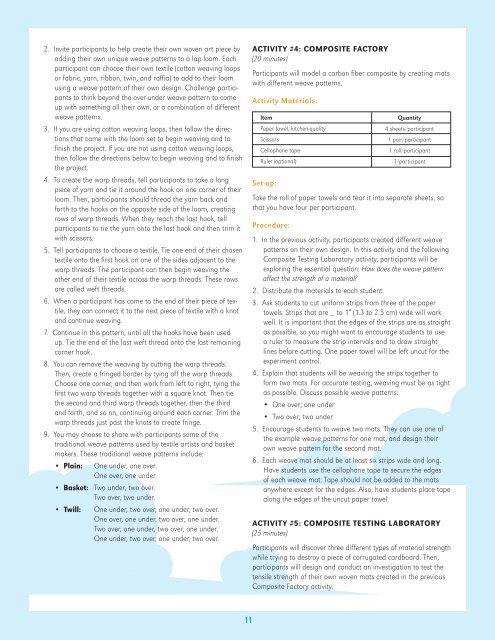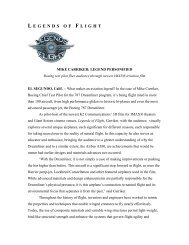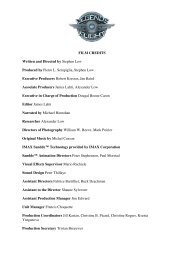download - Legends of Flight
download - Legends of Flight
download - Legends of Flight
Create successful ePaper yourself
Turn your PDF publications into a flip-book with our unique Google optimized e-Paper software.
2. Invite participants to help create their own woven art piece by<br />
adding their own unique weave patterns to a lap loom. Each<br />
participant can choose their own textile (cotton weaving loops<br />
or fabric, yarn, ribbon, twin, and raffia) to add to their loom<br />
using a weave pattern <strong>of</strong> their own design. Challenge participants<br />
to think beyond the over-under weave pattern to come<br />
up with something all their own, or a combination <strong>of</strong> different<br />
weave patterns.<br />
3. If you are using cotton weaving loops, then follow the directions<br />
that came with the loom set to begin weaving and to<br />
finish the project. If you are not using cotton weaving loops,<br />
then follow the directions below to begin weaving and to finish<br />
the project.<br />
4. To create the warp threads, tell participants to take a long<br />
piece <strong>of</strong> yarn and tie it around the hook on one corner <strong>of</strong> their<br />
loom. Then, participants should thread the yarn back and<br />
forth to the hooks on the opposite side <strong>of</strong> the loom, creating<br />
rows <strong>of</strong> warp threads. When they reach the last hook, tell<br />
participants to tie the yarn onto the last hook and then trim it<br />
with scissors.<br />
5. Tell participants to choose a textile. Tie one end <strong>of</strong> their chosen<br />
textile onto the first hook on one <strong>of</strong> the sides adjacent to the<br />
warp threads. The participant can then begin weaving the<br />
other end <strong>of</strong> their textile across the warp threads. These rows<br />
are called weft threads.<br />
6. When a participant has come to the end <strong>of</strong> their piece <strong>of</strong> textile,<br />
they can connect it to the next piece <strong>of</strong> textile with a knot<br />
and continue weaving.<br />
7. Continue in this pattern, until all the hooks have been used<br />
up. Tie the end <strong>of</strong> the last weft thread onto the last remaining<br />
corner hook.<br />
8. You can remove the weaving by cutting the warp threads.<br />
Then, create a fringed border by tying <strong>of</strong>f the warp threads.<br />
Choose one corner, and then work from left to right, tying the<br />
first two warp threads together with a square knot. Then tie<br />
the second and third warp threads together, then the third<br />
and forth, and so on, continuing around each corner. Trim the<br />
warp threads just past the knots to create fringe.<br />
9. You may choose to share with participants some <strong>of</strong> the<br />
traditional weave patterns used by textile artists and basket<br />
makers. These traditional weave patterns include:<br />
• Plain:<br />
• Basket:<br />
• Twill:<br />
One under, one over.<br />
One over, one under.<br />
Two under, two over.<br />
Two over, two under.<br />
One under, two over, one under, two over.<br />
One over, one under, two over, one under.<br />
Two over, one under, two over, one under.<br />
One under, two over, one under, two over.<br />
ACTIVITY #4: COMPOSITE FACTORY<br />
(20 minutes)<br />
Participants will model a carbon fiber composite by creating mats<br />
with different weave patterns.<br />
Activity Materials:<br />
Item<br />
Paper towel, kitchen-quality<br />
Scissors<br />
Cellophane tape<br />
Ruler (optional)<br />
Set-up:<br />
Quantity<br />
4 sheets/participant<br />
1 pair/participant<br />
1 roll/participant<br />
1/participant<br />
Take the roll <strong>of</strong> paper towels and tear it into separate sheets, so<br />
that you have four per participant.<br />
Procedure:<br />
1. In the previous activity, participants created different weave<br />
patterns on their own design. In this activity and the following<br />
Composite Testing Laboratory activity, participants will be<br />
exploring the essential question: How does the weave pattern<br />
affect the strength <strong>of</strong> a material?<br />
2. Distribute the materials to each student.<br />
3. Ask students to cut uniform strips from three <strong>of</strong> the paper<br />
towels. Strips that are _ to 1” (1.3 to 2.5 cm) wide will work<br />
well. It is important that the edges <strong>of</strong> the strips are as straight<br />
as possible, so you might want to encourage students to use<br />
a ruler to measure the strip intervals and to draw straight<br />
lines before cutting. One paper towel will be left uncut for the<br />
experiment control.<br />
4. Explain that students will be weaving the strips together to<br />
form two mats. For accurate testing, weaving must be as tight<br />
as possible. Discuss possible weave patterns:<br />
• One over; one under<br />
• Two over; two under<br />
5. Encourage students to weave two mats. They can use one <strong>of</strong><br />
the example weave patterns for one mat, and design their<br />
own weave pattern for the second mat.<br />
6. Each weave mat should be at least six strips wide and long.<br />
Have students use the cellophane tape to secure the edges<br />
<strong>of</strong> each weave mat. Tape should not be added to the mats<br />
anywhere except for the edges. Also, have students place tape<br />
along the edges <strong>of</strong> the uncut paper towel.<br />
ACTIVITY #5: COMPOSITE TESTING LABORATORY<br />
(25 minutes)<br />
Participants will discover three different types <strong>of</strong> material strength<br />
while trying to destroy a piece <strong>of</strong> corrugated cardboard. Then,<br />
participants will design and conduct an investigation to test the<br />
tensile strength <strong>of</strong> their own woven mats created in the previous<br />
Composite Factory activity.<br />
11





